Research - (2022) Volume 10, Issue 7
Evaluation of Flexural Strength of Fibre Splint Post Brushing Simulation-An In Vitro Study
R Saravanan and Jaiganesh Ramamurthy*
*Correspondence: Jaiganesh Ramamurthy, Department of Periodontics, Saveetha Institute of Medical and Technical Sciences (SIMATS) Saveetha University, Chennai, India, Email:
Abstract
Introduction:Splinting of the mobile teeth is a critical part of periodontal management to improve the prognosis and longevity of stable results of periodontally compromised teeth with increased mobility. Different types of splints are used in the dental field based on their mechanical and physical properties. Splinting device which joins two or more teeth in order to provide support and to reduce mobility. Tooth brush simulation which provides a normal cycle of toothbrush. In which toothbrush simulation provides the brushing in different types of fibre splints with different types of toothpaste to identify the flexibility of Interlig fibre splints and Techno fibre splint along with Colgate toothpaste and Dabur red paste. Materials and methods: 20 samples of teeth were subjected for the study. In which 16 samples on mandibular central incisors were tested and analysed and other 2 samples were control group.8 samples of tooth were bonded with Interlig fibre splint and Other 8 samples were bonded with Techno fibre splint. The samples were subjected into toothbrush simulation ZM 3.8 (SD Mechatronik) 8 samples of interlig fibre splint were splitted in which 4 samples had colgate toothpaste and other 4 samples of had dabur red toothpaste in toothbrush simulation. Techno fibre Splint samples were divided in which 4 sample had Colgate toothpaste and other 4 samples had dabur red toothpaste.20 samples of mandibular teeth were subjected to test the flexural strength in INSTRON E 3000 UTM(Universal Testing Machine) of two different fibre splint. Results: Flexural strength of Interlig fibre splint and Techno fibre plint were analyzed and the reading were recorded in computer software. Statistical analysis was done using SPSS2.0 software to identify the Mean differences between two different fibre splints. The results show that Techno splint has high flexural strength compared with Interlig splint. Interrelation between two different toothpaste of same splints were analysed the results shows that Interlig fibre splint and Technofibre splint of Colgate toothpaste has higher flexural strength compared with Dabur red toothpaste of Interlig fibre splint and Dabur red toothpaste. Conclusion: Flexural strength between Interlig fibre splints shows lesser strength compared with Techno fibre splints and flexural strength between two different toothpaste of different fibre splints were analyzed in which Interlig fibre splint and techno fibre splint with colgate toothpaste shows higher flexural strength compared with Dabur red tooth paste.
Keywords
Teeth, Colgate toothpaste, Dabur red paste, Fibre splints
Introduction
Tooth mobility is one among the foremost frequently encountered problems within the population which experience periodontal and periapical disease [1]. The splint, as described by the glossary of prosthodontics terms, may be a device that retains hard and/or soft tissue during a predetermined position [2]. Regular physiologic functions, like chewing and swallowing, are recognized to be suffering from tooth mobility. Splinting of affected teeth is a choice to improve the patients’ comfort and to supply better control of occlusion. Splinting often preserves patients from tooth extraction, prosthesis and implant [3,4]. Splinting is assessed by Weisgold as a brief lived method which is employed over a short time for fewer than six months, provisional or semipermanent which is employed for a couple of months to many years for diagnostic purposes, and a permanent splint which is worn indefinitely [5]. Different types of splint materials are utilized in dentistry supported their flexibility to permit movement of dental structures. Splinting materials like orthodontic wire, button splint, and fiber reinforced composite are attached to the teeth with the assistance of dental composites [6,7]. Elastic splint materials are oftentimes preferred, as they permit flexibility rather than rigid splinting. Hard splinting materials reduce the physiologic mobility of teeth, and thus might eliminate bone remodeling stimulation during a previously jeopardized periodontium [8]. The flexural strength represents the very best stress experienced within the fabric at its moment of yield. it's measured in terms of stress. Incidence of ankylosis may increase following improper selection of fabric or duration of splinting. Thus, the international association of dental traumatology (IADT) guideline recommends that splinting material should be flexible, somewhat rigid, and used for a brief duration of your time [9]. Rigid splints are more probably made up of materials possessing higher modulus of elasticity, for instance, composite resin material. Additional quality is that the flexure strength specifically is additionally termed as modulus of rupture, or transverse rupture strength may be a physical feature. Literature from the past revealed that the foremost signs for periodontitis are occlusal problems, progressive mobility, and migration of teeth due to periodontal or periapical derangement [10]. Splinting is assessed by Weisgold as a brief lived method which is employed over a short time for fewer than six months, provisional or semi-permanent which is employed for a couple of months to many years for diagnostic purposes, and a permanent splint which is worn indefinitely [11]. Within the literature, many indications are listed for tooth splinting, such as; to secure teeth that were orthodontically moved, to stabilize avulsed and luxated tooth, and to repair teeth that are periodontally compromised [12]. Even regular physiologic functions, like chewing and swallowing, are recognized to be suffering from tooth mobility [13,14]. Periodontal splinting has been supplied long-term retention of teeth, which has been used correctly can greatly improve the comfort, prognosis, and outcome of therapy for a patient with severe periodontal diseases [8,9]. Accumulation of bacterial plaque is etiologically linked to the event of both cavity [15,16] and periodontal disease. The mechanical removal of bacterial plaque plays a crucial role within the maintenance of oral health [17,18] through the prevention of caries and periodontitis [9,10]. Regular brushing with a toothbrush and dentifrice which will also include antimicrobials and other agents [19,20] may be a recommended and globally adopted method of controlling plaque. Brushing techniques differ between individuals for a spread of things including duration, pressure and coverage [21]. Such inter-individual variation may confound attempts to reproducibly identify and accurately quantify the consequences of for instance, brush type or dentifrice on plaque removal .The aim of the study is to spot the flexural strength of two different fibre splints.
Materials and Methods
A total of 10 samples were prepared using the two different fibre splinting materials by cutting them into a length of 8mm each from mid-point of one tooth to other teeth. Teeth were mounted in a square shape resin model and the resin model is mounted in the die stone. Then the fibre splint were mounted in mandibular central incisors on the labial surface of tooth in which acid etching done with orthophosphoric acid on the enamel surface for 60 seconds then washed away and the dry the enamel surface of tooth. Bonding agent were applied and fibre splints were mounted with composite and cured using curing light a photopolymerizable flowable composite resin was applied to the marked area and cured using a composite light curing unit. After splinting, the acrylic moulds were subjected to the toothbrush simulation (Figures 1 and 2).
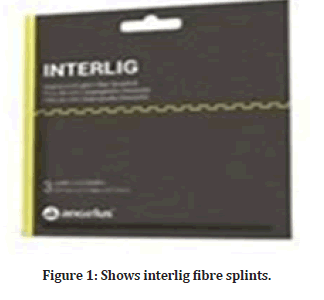
Figure 1: Shows interlig fibre splints.
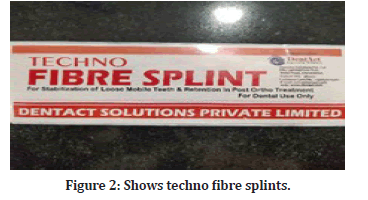
Figure 2:Shows techno fibre splints.
Tooth Brush simulation
The mounted tooth samples of two different fibre splints were placed in tooth brush simulator ZM 3.8. (SD Mechatronik). In the first cycle of toothbrush simulation 8 sample groups of interlig fibre splints were mounted. In which 1st half of 4 mounted tooth samples were applied with colgate toothpaste and other 2nd half of 4 mounted tooth samples were applied with dabur toothpaste. In 2nd cycle toothbrush simulation 8 sample groups of Techno splints were mounted in which 1st half of 4 mounted tooth samples were applied with colgate toothpaste and other 2nd half of 4 mounted tooth samples were applied with dabur toothpaste. Toothbrush simulation of 16 samples were mounted and kept in 5,000 cycles X axis .In which 2,500 cycles clockwise and 2,500 cycles of anticlockwise (Figures 3-5).
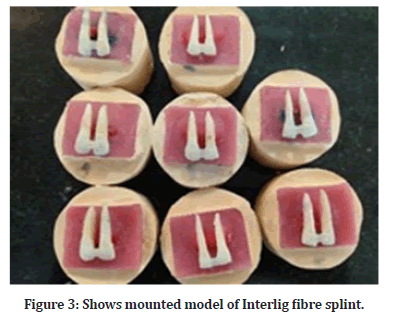
Figure 3:Shows mounted model of Interlig fibre splint.
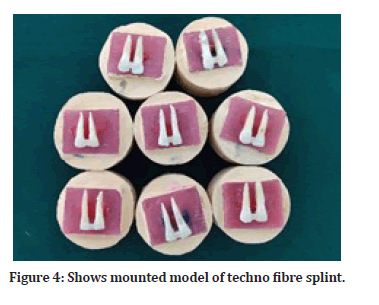
Figure 4:Shows mounted model of techno fibre splint.
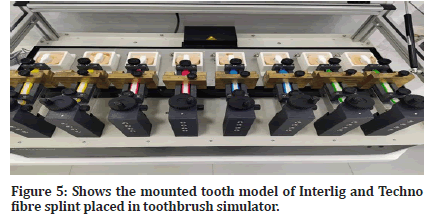
Figure 5:Shows the mounted tooth model of Interlig and Techno fibre splint placed in toothbrush simulator.
For testing flexural strength
Flexural strength of fiber splints were detected using INSTRON E 3000 UTM(Universal Testing Machine) which is used to test biomaterials .The prepared samples of fiber splints were kept to measure the flexural strength of both splints. The die stones were trimmed parallelly and kept in the machine in which the sample has to adapt properly when the maximum forces are given. The maximum force given was 3000 UTM (Figure 6).
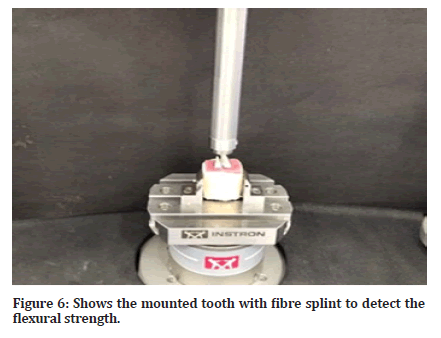
Figure 6:Shows the mounted tooth with fibre splint to detect the flexural strength.
The samples of interlig fibre splints and techno fibre splints were measured to detect the flexural strength in INSTRON E 3000 UTM which is used to detect the biomaterials. The force preset point cursor [N] were detected in two different splints and the detecte the results. Load deflection curves and measurement were recorded and displayed by the computer software of the testing materials procedure was repeated for all the test.
Samples and the breaking load values were recorded. The breaking load values were recorded in newton (N) and flexural strength (Mpa) was calculated with these breakage loading formula
S=3FL/2bd2
where, S=Flexural strength /modulus of fracture in Mpa(MegaPascals)
F=Load at the fracture point at which sample failed between load bearing edges,
L=Length of the support span (25mm)
b=Width of the test sample (2mm)
d=Thickness of the test sample (2mm)
Statistical analysis
All 16 samples of teeth were calculated using SPSS 23 version of Interlig fibre splints and techno fibre splints. In which mean and standard deviation of two fibre splints each samples were measured and inter group measurement between to different toothpaste of colgate and dabur red toothpaste in each different fibre splint were also measured. Comparison between two fibre splints was measured. Paired t test were done in both interlig fibre splints and techno fibre splint also analyzed in two different toothpaste of Colgate and dabur red toothpaste.
Results
Each sample of two different fibre splints was measured to detect the flexural strength in INSTRON E 3000 UTM of the biomaterials and the results were assessed in (Tables 1 and 2) shows the mean differences between interlig fibre splints and techno fibre splints (Table 3) shows the mean differences between interlig fibre splints between colgate toothpaste and dabur red toothpaste (Table 4) shows the mean differences between Techno fibre splints between colgate toothpaste and dabur red toothpaste (Figure 7) shows that techno fibre splint has higher resistance to flexural strength compared with interlig fibre splint. The mean differences between two different toothpaste of interlig splint were assessed (Figure 8) shows that interlig fibre splint with colgate toothpaste has higher flexural strength compared with dabur toothpaste and (Figure 9) shows the mean differences between techno fibre splint of two different toothpaste were assessed in which techno fibre splint with colgate toothpaste has higher flexural strength compared with dabur red toothpaste. In which interlig fibre splints and techno fibre splints (p value 0.790) not statistically significant, interlig fibre splints of different toothpastes colgate and dabur red (p value 0.917) not statistically significant and techno fibre splints of two different toothpastes of colgate and dabur red (p value 0.288) not statistically significant. Table 1 Shows the flexural strength between Interlig splint and techno splint with commercial toothpaste and herbal toothpaste and each splints were calculated using S=3FL/2bd2. Table 2 shows the mean differences between interlig fibre splints and techno fibre splints. Table 3 shows the mean and standard deviation of interlig splints between colgate toothpaste and dabur red toothpaste. Table 4 shows the mean and standard deviation of Techno splints between colgate toothpaste and dabur red toothpaste. Figure 7 shows the mean differences between interlig splints and techno splints. In which X axis shows groups and Y axis shows the mean of the different splints. In which interlig fibre splints (brown) and Techno fibre splints (Purple) Techno splints. In which techno fibre splints shows higher flexural splints compared with interlig fibre splints. Paired t test between interlig fibre splints and techno fibre splints were analysed (p value 0.790).In which statistically not significant. Figure 8 shows the mean differences between interlig splints of two different pastes. In which X axis shows types of toothpaste used in interlig splints and Y axis shows the mean of interlig splints. In which Interig splints of colgate toothpaste (Brown) and Interlig fibre splints of dabur red toothpaste (Red). Interlig fibre splints with Colgate toothpaste shows higher flexural strength compared with dabur red tooth paste. Paired t test were done between interlig fibre splints of Colgate and dabur red toothpaste (p value 0.917). In which statistically not significant. Figure 9 shows mean differences between techno splints of two different toothpastes. In which X axis shows types of toothpaste used in Techno splints and Y axis shows the mean of interlig splints. In which techno fibre splints colgate toothpaste (brown) and techno fibre splints dabur red toothpaste (Yellow).Techno splints with colgate toothpaste shows higher flexural strength compared with dabur red toothpaste. Paired t test were done between interlig fibre splints of colgate and dabur red toothpaste (p value 0.288).In which statistically not significant.
| S.No | Specimen Label | Force Preset Point Cursor[N] |
|---|---|---|
| 1 | Interlig-control | 20.84 |
| 2 | Interlig-colgate | 9.59 |
| 3 | Interlig-colgate | 9.01 |
| 4 | Interlig-colgate | 11.85 |
| 5 | Interlig-colgate | 4.36 |
| 6 | Interlig-Dabur herbal | 10.09 |
| 7 | Interlig-Dabur herbal | 18.12 |
| 8 | Interlig-Dabur herbal | 10.75 |
| 9 | Interlig-Dabur herbal | 10.64 |
| 10 | Techno-colgate | 59.53 |
| 11 | Techno-colgate | 58.94 |
| 12 | Techno-colgate | 55.28 |
| 13 | Techno-colgate | 51.06 |
| 14 | Techno-Dabur Herbal | 38.84 |
| 15 | Techno-Dabur Herbal | 24.56 |
| 16 | Techno-Dabur Herbal | 19.89 |
| 17 | Techno-Dabur Herbal | 75.62 |
| 18 | Techno-control | 21.95 |
Table 1: Flexural strength between Interlig splint and techno splint with commercial toothpaste and herbal toothpaste and each splints were calculated using S=3FL/2bd2.
| Interlig fibre splints | Techno fibre splints | |
|---|---|---|
| Mean | 45.0413 | 51.6875 |
| Standard deviation | 16.268 | 20.358 |
Table 2: Mean differences between interlig fibre splints and techno fibre splints.
| Interlig splints colgate toothpaste | Interlig splints dabur red toothpaste | |
|---|---|---|
| Mean | 52.215 | 37.8675 |
| Standard deviation | 18.86148 | 11.15958 |
Table 3: Mean and standard deviation of interlig splints between colgate toothpaste and dabur red toothpaste.
| Techno splints colgate toothpaste | Techno splints dabur red toothpastes | |
|---|---|---|
| Mean | 56.2025 | 39.7275 |
| Standard deviation | 3.909 | 25.2498 |
Table 4: Mean and standard deviation of Techno splints between colgate toothpaste and dabur red toothpaste.
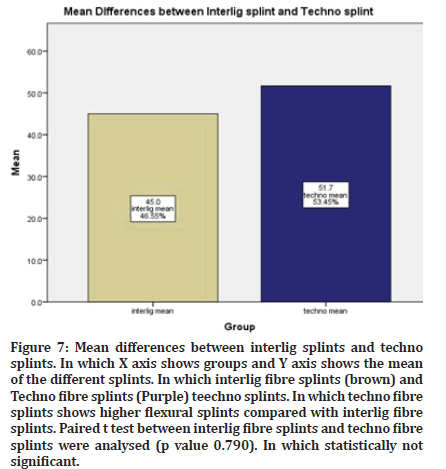
Figure 7:Mean differences between interlig splints and techno splints. In which X axis shows groups and Y axis shows the mean of the different splints. In which interlig fibre splints (brown) and Techno fibre splints (Purple) teechno splints. In which techno fibre splints shows higher flexural splints compared with interlig fibre splints. Paired t test between interlig fibre splints and techno fibre splints were analysed (p value 0.790). In which statistically not significant.
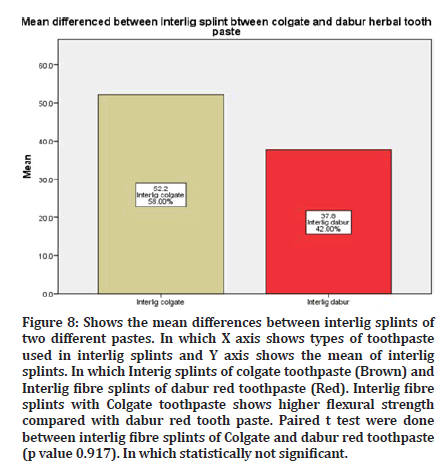
Figure 8:Shows the mean differences between interlig splints of two different pastes. In which X axis shows types of toothpaste used in interlig splints and Y axis shows the mean of interlig splints. In which Interig splints of colgate toothpaste (Brown) and Interlig fibre splints of dabur red toothpaste (Red). Interlig fibre splints with Colgate toothpaste shows higher flexural strength compared with dabur red tooth paste. Paired t test were done between interlig fibre splints of Colgate and dabur red toothpaste (p value 0.917). In which statistically not significant.
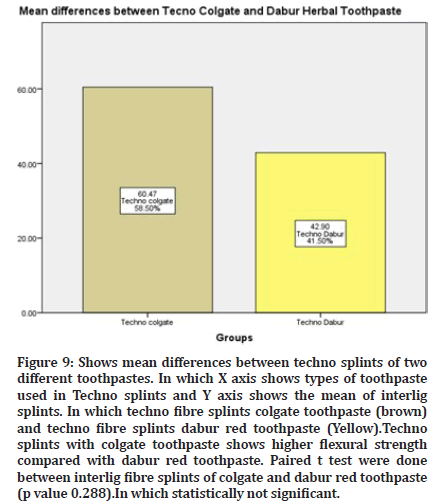
Figure 9:Shows mean differences between techno splints of two different toothpastes. In which X axis shows types of toothpaste used in Techno splints and Y axis shows the mean of interlig splints. In which techno fibre splints colgate toothpaste (brown) and techno fibre splints dabur red toothpaste (Yellow).Techno splints with colgate toothpaste shows higher flexural strength compared with dabur red toothpaste. Paired t test were done between interlig fibre splints of colgate and dabur red toothpaste (p value 0.288).In which statistically not significant.
Discussion
The results from the above study show that techno fibre splints have higher flexural strength compared with interlig fibre splint. One of the advantages of in vivo investigations with patients is the presence of a natural PDL. The disadvantages of assessing splint rigidity in healthy individuals include the shortage of increased tooth mobility, the danger of damaging sound enamel during splint removal, and therefore the limited availability of test persons [22]. Therefore in vitro studies using various types of models have also been conducted. The advantage of artificial models is that they're available anytime, and therefore the potential for intentional adjustment of tooth mobility. There is no risk of damaging sound enamel, as can happen in healthy individuals [23]. Flexural strength and flexural modulus plays a vital role in mechanical properties which were employed in earlier experiments to evaluate to the compare the physical properties of restorative materials [24,25]. Splint materials stay in position just by mechanical locking around the restorative material that could lead to generation of shear planes, stress concentration and the fracture of the composite failure of the splint system. Newer splinting like bondable, polyethylene woven ribbons, have succeeded the problems associated with older splint systems. Flexible splints like the fiber-composite splint and polyethylene fiber used to evaluate the flexibility. For evaluating splint rigidity tooth mobility assessment is required after treatment. The three-point bending test is a well-established tool used to evaluate flexural strength and flexural modulus in dental traumatology [26,27]. Reports from literature revealed that, in the past, mesh grids, wires and pins were frequently used with the adhesive systems for stabilization and splinting of teeth [28]. Ribbond® is a leno weave, ultra-high-molecular-weight polyethylene fiber with an ultra-high elastic modulus. The specially designed fiber network permits wetting of the fibers and the infusion of the resin into the fiber network [29]. The result of the present study showed that the Ribbond® was found to have the highest flexural strength, followed by F-splint-Aid®, ligature wire, InFibra®, and composite block having the least flexural strength. Less flexibility of glass fiber reinforced composite may be because of resin pre-impregnation of the fibers. Brushing force is a crucial factor for the development of abrasions. The results of a study conducted by Dave are in accordance with the results of the present study, which showed that the fiber reinforced ribbon was established to possess the utmost flexural strength and flexural modulus, followed by fiberglass and polyethylene fiber 32.Contrasting results were reported by Goldberg and Burstone in 1998, as they concluded that pre-impregnated fibers exhibit superior flexural strength because of their higher fiber units, attained during manufacturing procedure [30,31]. In summary, a model utilizing typodonts and simulated or biological plaque, together with standardized brushing parameters reproducing some characteristics of in situ dental plaque was wont to evaluate the effect of varied oral hygiene protocols. Data generated indicate that (i) plaque removal by standardized brushing (ii) that plaque removal was significantly augmented by the addition of toothpaste; and (iii) that brush head wear significantly reduced the removal of biofilms developed from mixed oral bacteria. Long duration in the oral cavity, strain allocation may be exaggerated by viscoelastic and biological bone reactions. The results of this study should use to measure the estimation of the early condition after a splint has been positioned.
Conclusion
Within limitation of the study we were able to analyze the flexural strength of two different fibre splints of Interlig fibre splints and Techno fibre splints. After examining Techno fibre splints has higher flexural strength compared with Interlig fibre splints. Further studies have to be done to identify the flexural strength of fibre splints.
Acknowledgement
The authors are thankful to the Director of academics, Chancellor and Dean of Saveetha Dental College and Hospitals for providing a platform to do research activities.
Conflict of Interest
The authors declare no potential conflict of interest.
References
- Ben Hassan MW, Andersson L, Lucas PW. Stiffness characteristics of splints for fixation of traumatized teeth. Dent Traumatol 2016; 32:140-5.
- Von Arx T, Filippi A, Lussi A. Comparison of a new dental trauma splint device (TTS) with three commonly used splinting techniques. Dent Traumatol 2001; 17:266-74.
- Hamilton RS, Pons PT. The efficacy and comfort of full-body vacuum splints for cervical-spine immobilization. J Emerg Med 1996; 14:553-9.
- Sonnenschein SK, Betzler C, Rütters MA, et al. Long-term stability of splinted anterior mandibular teeth during supportive periodontal therapy. Acta Odontol Scandal 2017; 75:475-82.
- Berthold C, Auer FJ, Potapov S, et al. Rigidity evaluation of quartz‐fiber splints compared with wire‐composite splints. Dent Traumatol 2012; 28:65-74.
- Berthold C, Thaler A, Petschelt A. Rigidity of commonly used dental trauma splints. Dent Traumatol 2009; 25:248-55.
- Kumbuloglu O, Saracoglu A, Özcan M. Pilot study of unidirectional E-glass fibre-reinforced composite resin splints: up to 4.5-year clinical follow-up. J Dent 2011; 39:871-7.
- Graetz C, Ostermann F, Woeste S, et al. Long-term survival and maintenance efforts of splinted teeth in periodontitis patients. J Dent 2019; 80:49-54.
- Andersson L, Andreasen JO, Day P, et al. International Association of Dental Traumatology guidelines for the management of traumatic dental injuries: 2. Avulsion of permanent teeth. Dent Traumatol 2012; 28:88-96.
- Tarnow DP, Fletcher P. Splinting of periodontally involved teeth: indications and contraindications. N Y State Dent J 1986; 52:24-5.
- Berthold C, Auer FJ, Potapov S, et al. Rigidity evaluation of quartz‐fiber splints compared with wire‐composite splints. Dent Traumatol 2012; 28:65-74.
- Oikarinen K. Functional fixation for traumatically luxated teeth. Dent Traumatol 1987; 3:224-8.
- Mosedale RF. Current indications and methods of periodontal splinting. Dent Update 2007; 34:168-80.
- Kathariya R, Devanoorkar A, Golani R, et al. To Splint or Not to Splint: The Current Status of Periodontal Splinting. J Int Acad Periodontol 2016; 18:45-56.
- Löe H, Theilade E, Jensen SB. Experimental gingivitis in man. J Periodontol 1965; 36:177-87.
- Espinoza JL, Harkins DM, Torralba M, et al. Supragingival plaque microbiome ecology and functional potential in the context of health and disease. mBio 9: e01631-18.
- Axelsson P, Lindhe J. The effect of a preventive programme on dental plaque, gingivitis and caries in schoolchildren. Results after one and two years. J Clin Periodontol 1974; 1:126-38.
- Pyysalo MJ, Mishra PP, Sundström K, et al. Increased tooth brushing frequency is associated with reduced gingival pocket bacterial diversity in patients with intracranial aneurysms. PeerJ. 2019; 7:e6316.
- Marsh PD, Head DA, Devine DA. Ecological approaches to oral biofilms: control without killing. Caries Res 2015; 49:46-54.
- Kumar S, Tadakamadla J, Johnson NW. Effect of toothbrushing frequency on incidence and increment of dental caries: a systematic review and meta-analysis. J Dent Res 2016; 95:1230-6.
- Wolff MS, Schenkel AB. The anticaries efficacy of a 1.5% arginine and fluoride toothpaste. Adv Dent Res 2018; 29:93-7.
- Haraszthy VI, Raylae CC, Sreenivasan PK. Antimicrobial effects of a stannous fluoride toothpaste in distinct oral microenvironments. 2019; 150:S14-24.
- Jepsen S, Blanco J, Buchalla W, et al. Prevention and control of dental caries and periodontal diseases at individual and population level: consensus report of group 3 of joint EFP/ORCA workshop on the boundaries between caries and periodontal diseases. J Clin Periodontol 2017; 44:S85-93.
- Berthold C, Holst S, Schmitt J, et al. An evaluation of the Periotest® method as a tool for monitoring tooth mobility in dental traumatology. Dent Traumatol 2010; 26:120-8.
- Narva KK, Lassila LV, Vallittu PK. Fatigue resistance and stiffness of glass fiber-reinforced urethane dimethacrylate composite. J Prosthet Dent 2004; 91:158-63.
- Ellakwa AE, Shortall AC, Shehata MK, et al. Influence of bonding agent composition on flexural properties of an Ultra-High Molecular Weight Polyethylene Fiber-Reinforced Composite. Oper Dent 2002; 27:184-91.
- Mazzoleni S, Meschia G, Cortesi R, et al. In vitro comparison of the flexibility of different splint systems used in dental traumatology. Dent Traumatol 2010; 26:30-6.
- Hoeppner MG, Fonseca RB, Pfau EA, et al. Rehabilitation of periodontally compromised teeth with fiber-reinforced composite resin: a case report. Quintessence Int 2011; 42.
- Sujeetha M, Rajaram V, Mahendra J. Stabilizing teeth with nonsurgical treatment—A report of two splinting cases. Int J Recent Sci Res 2018; 9:27616-8.
- Kemaloglu H, Pamir T, Tezel H. A 3-year randomized clinical trial evaluating two different bonded posterior restorations: Amalgam versus resin composite. Eur J Dent 2016; 10:016-22.
- Purayil TP, Chakravarthy A, Ginjupalli K, et al. Evaluation of bond strength of splinting materials to the teeth using three adhesive systems-an in vitro study. Saudi J Oral Sci 2015; 2:94.
Indexed at, Google Scholar, Cross Ref
Indexed at, Google Scholar, Cross Ref
Indexed at, Google Scholar, Cross Ref
Indexed at, Google Scholar, Cross Ref
Indexed at, Google Scholar, Cross Ref
Indexed at, Google Scholar, Cross Ref
Indexed at, Google Scholar, Cross Ref
Indexed at, Google Scholar, Cross Ref
Indexed at, Google Scholar, Cross Ref
Indexed at, Google Scholar, Cross Ref
Indexed at, Google Scholar, Cross Ref
Indexed at, Google Scholar, Cross Ref
Indexed at, Google Scholar, Cross Ref
Indexed at, Google Scholar, Cross Ref
Indexed at, Google Scholar, Cross Ref
Indexed at, Google Scholar, Cross Ref
Indexed at, Google Scholar, Cross Ref
Indexed at, Google Scholar, Cross Ref
Indexed at, Google Scholar, Cross Ref
Indexed at, Google Scholar, Cross Ref
Indexed at, Google Scholar, Cross Ref
Indexed at, Google Scholar, Cross Ref
Indexed at, Google Scholar, Cross Ref
Indexed at, Google Scholar, Cross Ref
Indexed at, Google Scholar, Cross Ref
Author Info
R Saravanan and Jaiganesh Ramamurthy*
Department of Periodontics, Saveetha Institute of Medical and Technical Sciences (SIMATS) Saveetha University, Chennai, IndiaReceived: 21-Jun-2022, Manuscript No. JRMDS-22-45712; , Pre QC No. JRMDS-22-45712 (PQ); Editor assigned: 23-Jun-2022, Pre QC No. JRMDS-22-45712 (PQ); Reviewed: 08-Jul-2022, QC No. JRMDS-22-45712; Revised: 13-Jul-2022, Manuscript No. JRMDS-22-45712 (R); Published: 20-Jul-2022
